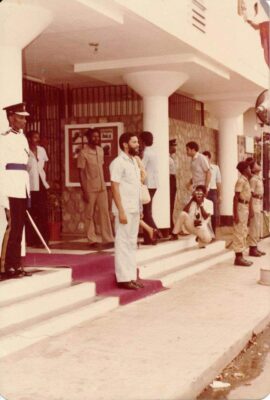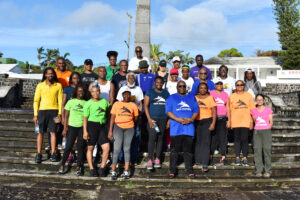Published 19 October 2021
Basseterre
Buckie Got It, St.Kitts and Nevis News Source
TODAY IN HISTORY – October 19, 1983 The Most Honourable Maurice Rupert Bishop was executed by firing squad.
Maurice Rupert Bishop was born on 29 May 1944 on the island of Aruba, then a colony of the Netherlands as part of the Netherlands Antilles. His parents, Rupert and Elment Bishop, were originally from Grenada and had migrated to Aruba to pursue employment opportunities. He moved to Grenada at age six (6) when is parents returned as entrepreneurs.
Maurice was an outstanding student, earning one of the four scholarships made available annually to attend the prestigious Presentation Brothers College. He was a student leader pivotal in the life of many student organizations while maintaining an outstanding academic performance. Notably, in early 1962, Bishop and youth leader from Grenada Boys’ Secondary School Bernard Coard, created the Grenada Assembly of Youth Fighting for Truth.
The objective of the organisation was to raise the consciousness of the island’s youth to political life through debates over pressing issues. Members gathered on Friday in St. George’s main square and arranged open political debates among the people. Bishop’s charisma and good oratory skills, including his skillful use of humor in his speeches became well known.
Bishop after completing university in 1969 (Law) became one of the founders of the Legal Aid Office of the West Indies Community in London’s Notting Hill Gate. During this period he corresponded with friends and developed a two-year plan of activities for his return to Grenada. The plan called for temporary withdrawal from participation in political activities and his work as a lawyer to co-create an organization capable of taking power on the island.
Returning to Grenada in December 1970, Bishop gave representation to the striking nurses at St. George’s General Hospital, who hoped to improve the living conditions of patients. He was arrested along with 30 other protestors. All were acquitted after a seven-month trial.
In 1972 Bishop helped organize a conference in Martinique that discussed and strategized actions for liberation movements. Movement for Assemblies of the People (MAP) which Bishop helped organize after the elections of 1972. Bishop and co-founders Kenrick Radix and Jacqueline Creft were interested in steering MAP toward construction of popular institutions centered in villages, to facilitate broad participation in the country’s affairs.
In January 1973 MAP merged with the Joint Endeavor for Welfare, Education, and Liberation (JEWEL) to form the New Jewel Movement (NJM). Bishop shared the leadership as Joint Coordinating Secretary with Unison Whiteman.
Grenada “Bloody Sunday”
On 18 November 1973, Bishop and other leaders of the New Jewel Movement were driving in two cars from St George’s to Grenville, where they were to meet with businessmen of the city. Security forces under Assistant Chief Constable Aynesent Belmar overtook Bishop’s motorcade. Nine people were captured, arrested, and beaten by the government. These events became known in Grenada as “Bloody Sunday.”
“Bloody Monday”
Bishop joined a mass demonstration against PM Eric Gairy on January 21, 1974. As his group returned to their hotel, they were pelted with stones and bottles by Gairy’s supporters, and the security forces used tear gas. Rupert Bishop, Maurice’s father, was leading women and children away from the danger, and was himself shot and killed at the door of the hotel. This became known in Grenada as “Bloody Monday.”
Bishop successfully contested the St. George’s seat in 1976 and assumed the position of leader of the opposition in parliament. On March 13, 1979, while Gairy was attending the United Nations session in New York, Bishop and his followers seized control of the government of Grenada.
Bishop established a relationship with Cuba after he took power. He initiated a number of projects, most significantly, the building of a new international airport on the island’s southern tip (renamed in his memory in May 2009).
Bishop’s Arrest and Execution
In 1983, disputes among the party leadership occurred. A military junta group within the party tried to make Bishop either step down or agree to a power-sharing agreement with Deputy Prime Minister Bernard Coard. Bishop rejected these proposals and was eventually deposed and placed under house arrest during the first week of October 1983 by Coard. Large public demonstrations throughout the island demanded Bishop’s freedom and restoration to power.
During one demonstration, the crowd freed Bishop from house arrest. Bishop made his way to the army headquarters at Fort Rupert (known today as Fort George). After he arrived, a military force was dispatched from Fort Frederick to Fort Rupert. Bishop and seven others, including cabinet ministers, were captured. Subsequently, Bishop, three members of his Cabinet and four others were killed. The bodies were then transported to a military camp and partially burned in a pit. The location of their remains is still unknown.
Partly as a result of Bishop’s murder, the Organization of Eastern Caribbean States (OECS) and the nations of Barbados and Jamaica appealed to the United States for assistance, as did Grenada’s governor-general Paul Scoon, and U.S. President Ronald Reagan launched an invasion.






